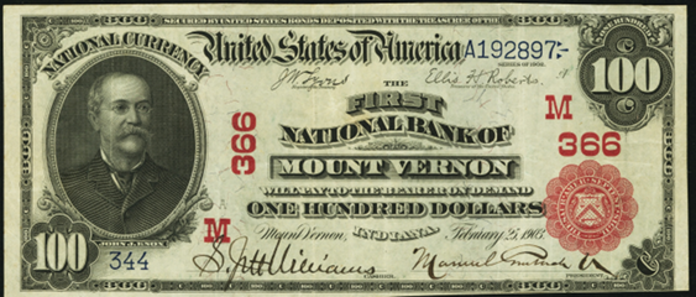One Hundred Dollar Notes › Nationals › 1902 One Hundred Dollar National Bank Notes › Alabama Charters › 1902 $100 Greenville Alabama First National Bank
Get Value Now
| Item | Info |
|---|---|
| Series | 1902 |
| Charter | #5572 First National Bank of Greenville, Alabama |
| Year Chartered | 1900, 422 Banks Chartered |
| City Info | Greenville is a city in Butler County, Alabama, United States. At the 2010 census, the population was 8,135. The city is the county seat of Butler County and is known as the Camellia City. The movement to change the official Alabama state flower from the goldenrod to the camellia originated in Greenville with legislative sponsors LaMont Glass and H.B. Taylor. Source: Wikipedia |
| Similar Cities | 28 banks with similar city. First 12 below: 1. Greenville, Pennsylvania - First National Bank 2. Greenville, Ohio - Farmers' National Bank 3. Greenville, Rhode Island - National Exchange Bank 4. Greenville, Illinois - First National Bank 5. Greenville, South Carolina - First National Bank 6. Greenville, Michigan - First National Bank 7. Greenville, Pennsylvania - Greenville National Bank 8. Greenville, Ohio - Second National Bank 9. Greenville, Texas - First National Bank 10. Greenville, Texas - Hunt County National Bank 11. Greenville, Michigan - City National Bank 12. Greenville, Texas - Greenville National Bank |
| Seal Varieties | Red, Blue |
| Other Info | 1. Value depends on notes known for charter, condition and market demand. |
| Neat Fact | Full and partial sheets of National Bank Notes are known to exists. Families of bank officials, particularly those who signed the notes, kept them as keepsakes. Some sheets are extremely valuable. Others are more common. |
No Obligations Offers and Appraisals
Please submit a good photo or scan. It will be identified and evaluated. Understand there may be subtle differences between the image you see above and your note. Signatures, design, markings and note condition will determine the offer price. Notes in Uncirculated or better condition receive the best offers.
Appraisals can be estimated for wholesale and retail prices. Wholesale is what dealers typically pay. Retail is what a collector might pay. Retail is slightly higher in most cases.
Please visit this page for USA Paper Money Reference. Do not treat this page as a reference guide, it is for appraisal and acquisition purposes only.
